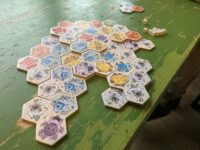- Learning time
- 20 minutes
- First play time
- 30 minutes
Akropolis
Designed by: Jules Messaud
In Akropolis, each player is an architect, building their own city out of tiles: and the best-laid city will be the winner.
Everyone gets a starting tile and some stones. A number of city tiles are flipped over into a row, and play begins. On your turn you can take the bottom-most tile for free, or pay a stone back to the supply for each tile you skip over to take from further up the row.
Having taken a tile, you must now add it to your city, and this is the nub of the game because where the tile – and subsequent tiles – go defines the worth of your city. Each tile is made of three hexes, and each hex represents constructions that demand certain criteria in order to score points at the end of the game. Houses want to be next to other houses, markets want to be isolated from other markets, barracks want to be on the edge of your city, temples want to be surrounded by other tiles and finally the gardens are the only hex that will score points no matter where they are. Note as well that you can build your city upwards as well as outwards, covering lower tiles in order to do so. Sacrificing the lower hexes to do this can be very worthwhile, because the higher your build, the more valuable each hex potentially becomes. And if you build over the otherwise-worthless quarries, you gather stones for doing so.
But! None of the constructions will score at all unless you get some plazas. The plazas match the colour of the constructions, but don’t need to be adjacent: it doesn’t matter where you place them. At the end of the game, you’ll score the number of your constructions multiplied by the matching plazas. So for instance if I’ve four markets on level one (4) and a market on both levels two and three (2+3) then I have a total of nine points to be multiplied by my market plazas. The plazas themselves can have a value of one, two, or three, and I’ve managed to get a combined plaza value of six, so I multiple 6×9 to score my markets.
Everyone scores a point for each stone in their possession, and the player with the most points wins!
The guru's verdict
-
Take That!
Take That!
Players can't interfere with each other's cities at all, but you can certainly take a tile to stop others hauling in a big chunk of points from it.
-
Fidget Factor!
Fidget Factor!
Low to moderate, depending on who's playing.
-
Brain Burn!
Brain Burn!
You can have strategies here, but you'll need some tactical flexibility along with it, as tiles are gobbled up by others and plans change.
-
Again Again!
Again Again!
The tiles come out randomly and frankly, that's enough to make Akropolis replayable on it's own terms. But it also has variant suggestions in the box.













Sam says
Probably best with 2 or 3 players rather than the full quartet Akropolis can host, this is a simple little game that - despite the mathy efforts to explain it here - is easy to teach once you know it yourself, and plays rapidly; for two people it only takes about 15 minutes! I like the simplicity and accessibility, and how an elementary set of rules give you tough decisions. You can also play focused on your own city or take a more passive-aggressive approach, spotting what others are going for and making sure they don't get it. Outside of that Akropolis doesn't get my blood pumping: to my tastes each play feels slightly like generating a scoring system rather than an urban sprawl. I find something like NEOM a little more engaging for a city builder, but then what Akropolis has over games like it is how immediate everything is.